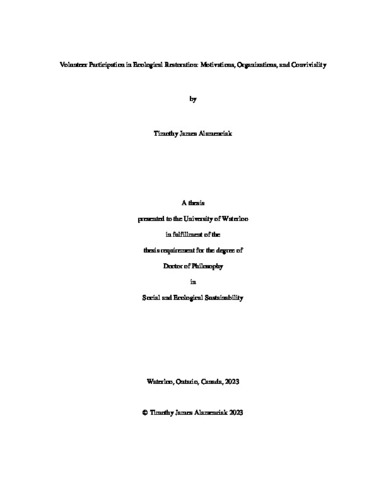| dc.description.abstract | The state of ecosystems worldwide are increasingly dire. Ecological restoration is a practice that has the potential to remedy ecosystem degradation. Engaging people in ecological restoration can help ensure project success, increase community acceptance and spread the practice of restoration beyond professionals. Research that focuses on volunteer engagement has revealed varying motivations for volunteering and a preference for well-organized projects. That research has seldom examined community-led ecological restoration (i.e. voluntary activities not organized by a non-profit). Despite extensive research into volunteer motivation, there remains little consensus on what motivates people to participate in ecological restoration and, accordingly, no clear guidance for practitioners who seek to appeal to motivations. Similarly, while project organization has been identified as an important characteristic, it is not clear what constitutes a well-organized project. By filling knowledge gaps around community participation in ecological restoration, the science and practice can have a cultural impact as well as an ecological one. The UN Decade on Ecosystem Restoration (2021-2030) has a stated goal of creating a culture of restoration. A better understanding of participation can help meet that goal.
This dissertation consists of three studies conducted in order to expand knowledge of volunteer participation. First, a systematic map of the literature on volunteer motivation resulted in a typology of the 15 most commonly studied motivations. Second, a survey of volunteers for nature-based non-profits clarifies project organization and its connection to volunteer engagement. Third, a qualitative case study of a community project operationalizes grassroots ecological restoration, specifically exploring the concept of a convivial community tool. Together they reveal the importance of relationships between volunteers and the ability of interconnected groups to overcome barriers to engagement in ecological restoration.
Engagement is a core principle of ecological restoration, and volunteering is a central means by which communities become engaged in ecological restoration projects. This chapter addressed the question: What are the motivations to participate in ecological restoration projects? The systematic literature map method was used to answer these questions. The research resulted in a typology of motivations examined by the studies that consists of 15 categories. A network analysis of those categories revealed five core and ten additional motivations that co-occur most in the literature: having a positive environmental impact, acquiring and sharing knowledge, caring for the environment, social interactions and community, and human health and wellbeing. Barriers to volunteering and the demographics of volunteers were also mapped in the literature as they appeared frequently alongside motivations. The five core motivations should be taken as a set of widely studied and well-understood motivations which can inform program design. The systematic map also highlights three major areas for future research: extrinsic motivations, demographics of volunteers who participate in ecological restoration and project organization as a motivation.
Project organization is an under-studied but important aspect of motivation to participate in ecological restoration that contributes to long-term engagement in restoration. Early studies on volunteer commitment recognized people are more engaged in well-organized projects, but there is a lack of understanding around what aspects of project organization are tied to volunteer engagement. One framework links performance of community-based initiatives to three aspects: social capital, transformational leadership and organizational capacity. We tested and extended that framework using a survey of volunteers for ecological restoration and conservation projects in Ontario, Canada. Volunteer engagement is a primary goal of many nature organizations. Social capital was most strongly correlated with volunteer engagement. A path analysis of four latent variables resulted in a model that shows transformational leadership (β = 0.37; P < 0.001) and organizational capacity (β = 0.297; P < 0.01) are strongly correlated with social capital, which in turn is correlated with volunteer engagement (β = 0.653; P < 0.01). Practitioners seeking to improve the engagement of their volunteers should emphasize building social capital to enhance volunteer engagement in community-based initiatives.
The majority of restoration research focuses on professional practices rather than community-led initiatives. As a result, there is little understanding of how laypeople engage in ecological restoration. Native plant gardening is growing in popularity as a means of addressing the degradation in urban landscapes, but it remains in opposition to the norms of wider society, and particularly the horticultural industry. The Ottawa Wildflower Seed Library is an organization that is trying to change the norm by supporting native plant gardeners with free seeds, advice and a supportive community. We expand and adapt Illich’s ‘convivial community tool’ to ecological restoration through a case study of the seed library. A convivial community tool is an approach to providing a tool (e.g. native seeds) that emphasizes accessibility rather than restricting who can access the tool. Through semi-structured interviews, participants discussed themes including accessibility, community and emergence. By focusing on accessibility, the seed library distinguishes itself from other non-profits with similar missions.
This dissertation contributed knowledge on community engagement in ecological restoration, adding to the field’s understanding of volunteer motivations, project organization and grassroots action. Taken together, these papers reveal the importance of relationships to restoration outcome and outline a convivial approach to restoration practice. This research will help practitioners engage more people in ecological restoration, which will ultimately result in increased project success. | en |

